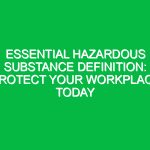Welcome Team!
Today, we are here to conduct an important toolbox talk focused on preventing heat-related illnesses, specifically Heat Stroke. As we dive into the warmer months, it’s vital to understand how high temperatures can impact our health and Safety on the job. Heat stroke is not just a term; it is a serious medical condition that can occur when our bodies overheat, often due to prolonged exposure to high temperatures or physical exertion. By the end of this discussion, you will have a solid understanding of Heat Stroke, its symptoms, prevention strategies, and the necessary actions to take if it occurs.
Understanding Heat Stroke
Heat Stroke is the most severe form of heat illness. It occurs when the body temperature rises to 104°F (40°C) or higher, leading to potential damage to the body’s organs. This condition can develop rapidly, especially during vigorous work in hot environments.
- Risk Factors: Certain factors can elevate the risk of Heat Stroke, including high humidity, lack of acclimatization to heat, dehydration, and wearing heavy or non-breathable clothing.
- Who is Affected: Anyone can suffer from Heat Stroke, but those who are elderly, have chronic illnesses, or are overweight are particularly vulnerable.
Symptoms of Heat Stroke
Recognizing the symptoms of Heat Stroke is crucial for timely intervention. Symptoms may include:
- High body temperature
- Altered mental state or confusion
- Nausea and vomiting
- Rapid breathing and heart rate
- Throbbing headache
- Skin that is hot and dry, or profusely sweating
If you or a coworker exhibit any of these symptoms, it is critical to act quickly.
Preventing Heat Stroke: Best Practices
Prevention is the best strategy for avoiding Heat Stroke. Here are some essential tips to keep in mind:
- Stay Hydrated: Drink plenty of water before, during, and after work. Aim for at least 8 ounces every 20 minutes, or more if you are sweating heavily.
- Take Breaks: Schedule regular breaks in a shaded or cool area to allow your body to cool down. Use this time to hydrate and rest.
- Wear Appropriate Clothing: Use lightweight, loose-fitting, and light-colored clothing. This allows for better airflow and helps keep your body cool.
- Know the Signs: Be aware of the symptoms of Heat Stroke so you can identify them in yourself and your coworkers quickly.
- Acclimatization: Allow your body to adjust to the heat gradually. If you are new to hot environments, start with shorter work periods and gradually increase your exposure.
Real-Life Examples
Let’s take a look at a few real-life scenarios to illustrate the importance of these preventive measures:
Consider a construction crew working on a hot summer day. One of the workers, John, has been on the site for several hours without taking a break. He starts feeling dizzy and confused. Luckily, his colleague notices and encourages him to take a break and drink some water. This quick action prevents John from suffering from Heat Stroke.
In another scenario, a landscaping team is working in direct sunlight. They have scheduled breaks every hour, allowing everyone to rehydrate and cool down. Because they are proactive, none of the team members encounter severe heat-related illnesses.
What to Do If Someone Shows Symptoms of Heat Stroke
If you suspect someone is experiencing Heat Stroke, follow these steps:
- Call for Help: Alert a supervisor or call emergency services immediately.
- Move the Person: Get the affected individual to a cooler Environment, preferably indoors or in the shade.
- Cool Them Down: Use cool water, ice packs, or wet cloths to lower their body temperature. Focus on areas like the neck, armpits, and groin.
- Monitor Their Condition: Keep an eye on their symptoms while waiting for medical help.
Company Policies and Compliance
It is essential to adhere to our company policies regarding Heat Safety. These policies align with Occupational Safety and Health Administration (OSHA) guidelines and are designed to protect you from heat-related illnesses, including Heat Stroke. Compliance not only ensures your Safety but also protects the company from potential legal liabilities.
As part of our commitment to safety, we require:
- Regular safety Training sessions focusing on heat-related risks.
- Access to hydration stations throughout the work area.
- Immediate reporting of any health concerns related to heat exposure.
Engagement and Discussion
Before we wrap up, let’s open the floor for some discussion. Here are a few questions to consider:
- Have you ever experienced symptoms of Heat Stroke? How did you handle it?
- What strategies do you think could further improve our heat safety practices?
- Can anyone share personal experiences or observations related to heat safety in the workplace?
These questions are meant to promote an open dialogue about our collective responsibility in maintaining a safe environment.
Conclusion
In conclusion, understanding and preventing Heat Stroke is crucial for everyone’s safety on the job. Remember the key practices: hydrate, take breaks, wear appropriate clothing, and know the symptoms. By applying these strategies, we can create a safer workplace for ourselves and our colleagues.
Thank you for your attention and commitment to safety today. Let’s take these lessons to heart, look out for one another, and ensure we all return home healthy and safe!


